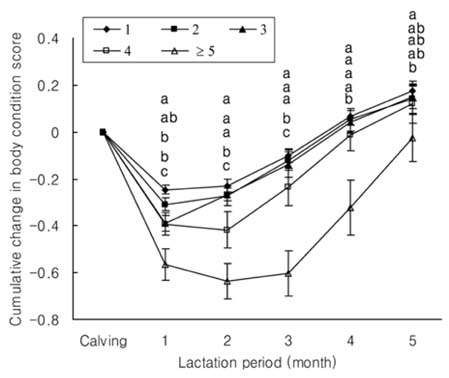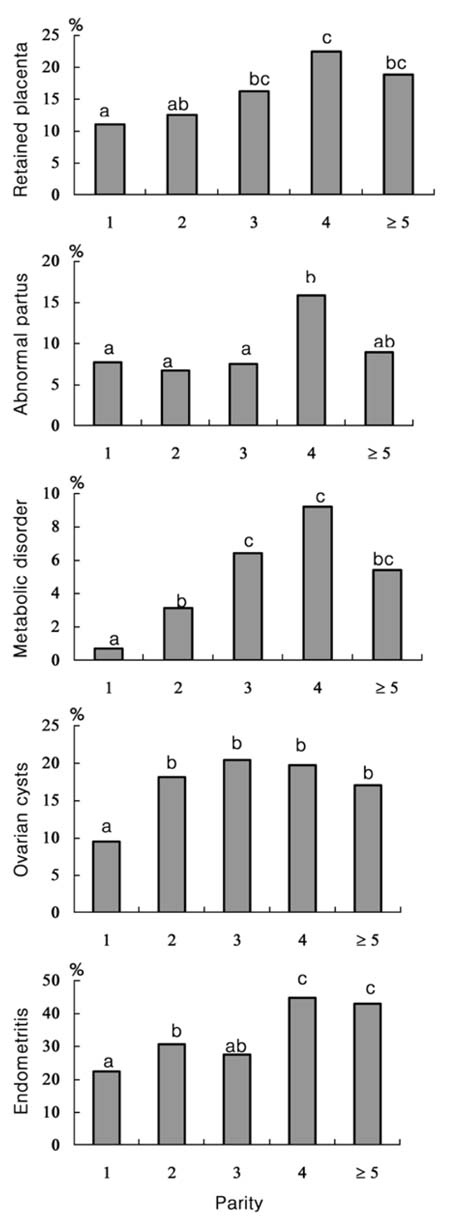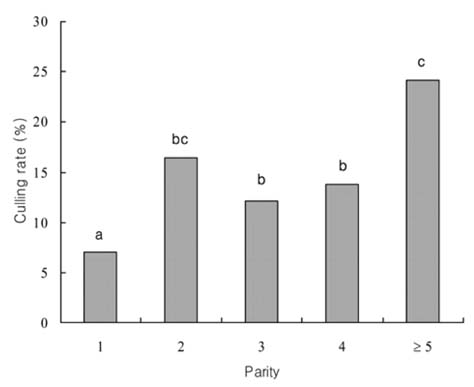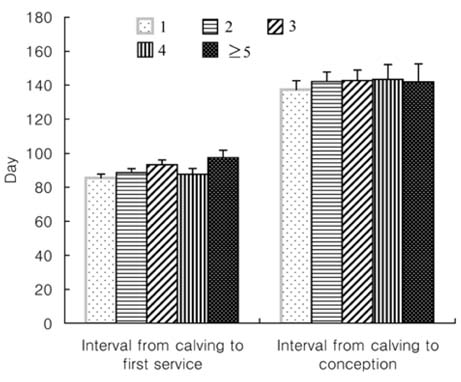J Vet Sci.
2006 Jun;7(2):161-166. 10.4142/jvs.2006.7.2.161.
Advancing parity is associated with high milk production at the cost of body condition and increased periparturient disorders in dairy herds
- Affiliations
-
- 1College of Veterinary Medicine, Chungbuk National University, Cheongju 361-763, Korea. illhwa@cbu.ac.kr
- KMID: 1059203
- DOI: http://doi.org/10.4142/jvs.2006.7.2.161
Abstract
-
The objectives of this study were to determine the
effects of parity on milk production, body condition
change, periparturient health, and culling in Korean
dairy herds. The data utilized included; milk yield, body
condition score, cow parity, calving condition, periparturient
disorders, culling, and reproductive status, which were
recorded from 1290 calvings in eight dairy herds. The
mean milk yield in cows over 305 days increased with
increasing parity (p < 0.01). Cows with parities of 3, 4, and
5 or higher lost more body condition than those with a
parity of 1 during month 1 of lactation (p < 0.01), and
body condition recovery by cows with parities of 4 and 5
or higher was slower (p < 0.01) than recovery by cows
with parities of 1, 2, or 3 until month 3 of lactation. The
risk of retained placenta, metabolic disorder, and
endometritis also increased with advancing parity (p <
0.05). Moreover, the incidence of ovarian cysts was lower
in cows with a parity of one than in cows with greater
parities (p < 0.01). Culling rate due to reproductive failure
also increased with advancing parity (p < 0.01). These
results
suggest that parity increases milk yield, body condition loss during early lactation, the risk of periparturient disorders, and culling due to reproductive failure in dairy herds.
Keyword
MeSH Terms
Figure
Cited by 3 articles
-
Associations between the clinical signs of chronic endometritis with ovarian cysts and body condition loss in German Holstein Friesian cows
Georgios Tsousis, Reza Sharifi, Martina Hoedemaker
J Vet Sci. 2009;10(4):337-341. doi: 10.4142/jvs.2009.10.4.337.Risk factors for delayed conception in Korean dairy herds
Ill-Hwa Kim, Hyun-Gu Kang
J Vet Sci. 2006;7(4):381-385. doi: 10.4142/jvs.2006.7.4.381.Pregnancy loss in dairy cows: the contributing factors, the effects on reproductive performance and the economic impact
Je-In Lee, Ill-Hwa Kim
J Vet Sci. 2007;8(3):283-288. doi: 10.4142/jvs.2007.8.3.283.
Reference
-
1. Beaudeau F, Ducrocq V, Fourichon C, Seegers H. Effect of disease on length of productive life of French Holstein dairy cows assessed by survival analysis. J Dairy Sci. 1995. 78:103–117.
Article2. Bell AW. Regulation of organic nutrient metabolism during transition from late pregnancy to early lactation. J Anim Sci. 1995. 73:2804–2819.
Article3. Bigras-Poulin M, Meek AH, Martin SW. Interrelationships of health problems and age on milk production in selected Ontario Holstein cows. Prev Vet Med. 1990. 8:3–13.
Article4. Butler WR, Smith RD. Interrelationships between energy balance and postpartum reproductive function in dairy cattle. J Dairy Sci. 1989. 72:767–783.
Article5. Correa MT, Erb H, Scarlett J. Path analysis for seven postpartum disorders of Holstein cows. J Dairy Sci. 1993. 76:1305–1312.
Article6. de Vries MJ, van der Beek S, Kaal-Lansbergen LM, Ouweltjes W, Wilmink JB. Modeling of energy balance in early lactation and the effect of energy deficits in early lactation on first detected estrus postpartum in dairy cows. J Dairy Sci. 1999. 82:1927–1934.
Article7. Dematawewa CMB, Berger PJ. Genetic and phenotypic parameters for 305-day yield, fertility, and survival in Holsteins. J Dairy Sci. 1998. 81:2700–2709.
Article8. Dohoo IR, Martin SW. Disease, production and culling in Holstein-Friesian Cows. V. Survivorship. Prev Vet Med. 1984. 2:771–784.
Article9. Domecq JJ, Skidmore AL, Lloyd JW, Kaneene JB. Relationship between body condition scores and conception at first artificial insemination in a large dairy herd of high yielding Holstein cows. J dairy Sci. 1997. 80:113–120.
Article10. Drackley JK. Biology of dairy cows during the transition period: the final frontier? J Dairy Sci. 1999. 82:2259–2273.
Article11. Edmonson AJ, Lean IJ, Weaver LD, Farver T, Webster G. A body condition scoring chart for Holstein dairy cows. J Dairy Sci. 1989. 72:68–78.
Article12. Emanuelson U, Oltenacu PA. Incidences and effects of diseases on the performance of Swedish dairy herds stratified by production. J Dairy Sci. 1998. 81:2376–2382.
Article13. Erb HN, Martin SW. Interrelationships between production and reproductive diseases in Holstein cows. Age and seasonal patterns. J Dairy Sci. 1980. 63:1918–1924.
Article14. Erb HN, Martin SW, Ison N, Swaminathan S. Interrelationships between production and reproductive diseases in Holstein cows. Path analysis. J Dairy Sci. 1981. 64:282–289.
Article15. Erb HN, Smith RD, Oltenacu PA, Guard CL, Hillman RB, Powers PA, Smith MC, White ME. Path model of reproductive disorders and performance, milk fever, mastitis, milk yield, and culling in Holstein cows. J Dairy Sci. 1985. 68:3337–3349.
Article16. Farin PW, Youngquist RS, Parfet JR, Garverick HA. Diagnosis of luteal and follicular ovarian cysts in dairy cows by sector scan ultrasonography. Theriogenology. 1990. 34:633–642.
Article17. Fleischer P, Metzner M, Beyerbach M, Hoedemaker M, Klee W. The relationship between milk yield and the incidence of some diseases in dairy cows. J Dairy Sci. 2001. 84:2025–2035.
Article18. Fourichon C, Seegers H, Malher X. Effect of disease on reproduction in the dairy cow: a meta-analysis. Theriogenology. 2000. 53:1729–1759.
Article19. Gallo L, Carnier P, Cassandro M, Mantovani R, Bailoni L, Contiero B, Bittante G. Change in body condition score of Holstein cows as affected by parity and mature equivalent milk yield. J Dairy Sci. 1996. 79:1009–1015.
Article20. Gilbert RO, Gröhn YT, Miller PM, Hoffman DJ. Effect of parity on periparturient neutrophil function in dairy cows. Vet Immunol Immunopathol. 1993. 36:75–82.
Article21. Gröhn YT, Rajala-Schultz PJ. Epidemiology of reproductive performance in dairy cows. Anim Reprod Sci. 2000. 60-61:605–614.
Article22. Gröhn YT, Rajala-Schultz PJ, Allore HG, DeLorenzo MA, Hertl JA, Galligan DT. Optimizing replacement of dairy cows: modeling the effects of diseases. Prev Vet Med. 2003. 61:27–43.
Article23. Heuer C, Schukken YH, Dobbelaar P. Postpartum body condition score and results from the first test day milk as predictors of disease, fertility, yield, and culling in commercial dairy herds. J Dairy Sci. 1999. 82:295–304.
Article24. Kim IH, Suh GH. Effect of the amount of body condition loss from the dry to near calving periods on the subsequent body condition change, occurrence of postpartum diseases, metabolic parameters and reproductive performance in Holstein dairy cows. Theriogenology. 2003. 60:1445–1456.
Article25. Klerx HJ, Smolders EAA. Herd and cow random variation in models of interrelationships between metabolic and reproductive disorders in high yielding multiparous Holstein dairy cattle in The Netherlands. Livest Prod Sci. 1997. 52:21–30.
Article26. Lee HC. 2004 DHI Annual Report in Korea. 2005. Seoul: Dairy Cattle Improvement Center, National Agricultural Cooperative Federation;34–65.27. Loeffler SH, de Vries MJ, Schukken YH. The effects of time of diseases occurrence, milk yield, and body condition on fertility of dairy cows. J Dairy Sci. 1999. 82:2589–2604.
Article28. Lucy MC, Staples CR, Michel FM, Thatcher WW. Energy balance and size and number of ovarian follicles detected by ultrasonography in early postpartum dairy cows. J Dairy Sci. 1991. 74:473–482.
Article29. Markusfeld O. Factors responsible for post parturient metritis in dairy cattle. Vet Rec. 1984. 114:539–542.
Article30. Markusfeld O. Periparturient traits in seven high dairy herds. Incidence rates, association with parity, and interrelationships among traits. J Dairy Sci. 1987. 70:158–166.
Article31. Opsomer G, Gröhn YT, Hertl J, Coryn M, Deluyker H, de Kruif A. Risk factors for post partum ovarian dysfunction in high producing dairy cows in Belgium: a field study. Theriogenology. 2000. 53:841–857.
Article32. Rajala-Schultz PJ, Gröhn YT. Culling of dairy cows. Part II. Effects of diseases and reproductive performance on culling in Finnish Ayrshire cows. Prev Vet Med. 1999. 41:279–294.
Article33. SAS. SAS System, Release 8.1. 1999. Cary: SAS Inst.34. Seegers H, Beaudeau F, Fourichon C, Bareille N. Reasons for culling in French Holstein cows. Prev Vet Med. 1998. 36:257–271.
Article35. Tebble JE, O'Donnell MJ, Dobson H. Ultrasound diagnosis and treatment outcome of cystic ovaries in cattle. Vet Rec. 2001. 148:411–413.
Article36. Waltner SS, McNamara JP, Hillers JK. Relationships of body condition score to production variables in high producing Holstein dairy cattle. J Dairy Sci. 1993. 76:3410–3419.
Article
- Full Text Links
- Actions
-
Cited
- CITED
-
- Close
- Share
- Similar articles
-
- Risk factors for delayed conception in Korean dairy herds
- Risk factors for retained placenta and the effect of retained placenta on the occurrence of postpartum diseases and subsequent reproductive performance in dairy cows
- Associations between the clinical signs of chronic endometritis with ovarian cysts and body condition loss in German Holstein Friesian cows
- Pregnancy loss in dairy cows: the contributing factors, the effects on reproductive performance and the economic impact
- Preference and Consumption Pattern of Middle and High School Students on Milk and Milk Products, in Geochang Area






